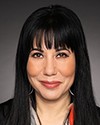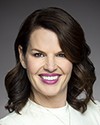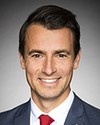[Witness spoke in Anishinaabemowin as follows:]
Kwey, Belle Bailey nid-ijinikàz. Pikwakanagan nid-ondjibà. Makwà ashidj mikinàk nidòdem.
[English]
My name is Belle Bailey. I'm an Algonquin from the Pikwakanagan First Nation, and I have been passionate about sport my whole life.
In 2017, I had the honour to be chosen to represent Team Ontario at the North American Indigenous Games as an athlete. In 2020, I was hired by Indigenous Sport and Wellness Ontario to help administer many aspects of the same provincial sports body. It is a role I am still in today and enjoy very much.
In 2023, I will be coaching the Ontario badminton team as we travel to Nova Scotia next summer to compete at the North American Indigenous Games once again.
I am here to speak to you today on behalf of Indigenous Sport and Wellness Ontario, and, for the remainder of this speech, I will be referring to the organization by its acronym, ISWO.
ISWO is the designated provincial aboriginal sport body for Ontario, serving all indigenous peoples and communities across the province, including first nation, Inuit and Métis living on and off reserve in rural and urban settings.
Our organization develops opportunities for participation in sport and cultural activities that promote wellness and positive lifestyles. We have implemented a women and girls program that is intended to increase opportunities for them to participate in sport, recreation and physical activity while empowering them through increased confidence, capacity and knowledge.
Recently, we developed a women and girls sport fund and organized the first-ever Sharing our Strength women and girls conference.
We would like to put forward the following observations.
First is that gender equality in sport in our country is grossly imbalanced. It is common knowledge that girls' sport participation rates decrease as they enter adolescence, leading to a dropout rate of one in three girls leaving sport by their teens. By ages 19 to 24, that number is reduced to a 34% participation rate. For indigenous women and girls, this disparity is even worse, with only a 24% participation rate starting in their teenage years.
Our second observation is that Canadian sports media don't provide proper representation of women athletes who could act as role models for youth. Studies show the 92.6% of content is solely related to men's sport coverage; however, additional research shows that Canadians want to watch women's sport content. The issue is that they can't find a place to watch it. As you can imagine, similar information on the representation of indigenous people in the sports media is almost non-existent. Representation matters.
Our third observation is that conscious and unconscious gender bias plays a huge role in all aspects of sport. Women's abilities and skills are systematically underestimated. This perceived inequality is a barrier to sport for women and girls. Men are viewed with the assumption that they are competent in sport. Women must first prove themselves and then fight every day to show that they are competent. Once the element of racial bias is added regarding indigenous people to the bias that already exists for women, one can easily see the uphill battle that must be fought.
Last is our fourth observation: This conversation leads directly to pay equity, as there is a correlation between lower wages being caused by the lack of media coverage and under-representation in leadership roles. While Canada has made strides in this regard, much more work is needed.
ISWO would like to make the following recommendations.
The first is to increase sports programming targeted specifically to women and girls that creates safe spaces for them to pursue physical activity and wellness opportunities. This will reduce psychosocial barriers to recreation, health and wellness. These opportunities can put women and girls on the sport pathway to participating in sport for life.
Our second recommendation is to showcase and celebrate more female athletes as a whole. This also includes showcasing more indigenous women and girls succeeding in sport. By recognizing and acknowledging athletic excellence and sharing the stories of success, we can continue to inspire and provide role models for younger athletes to look up to. As previously stated, representation matters. What you cannot see, you cannot become.
The third recommendation is that the Government of Canada's commitment to achieving gender equity in sport at all levels by 2035, in our opinion, is much too late. Recent surveys have shown that one in four girls aren't committed to returning to their prepandemic sports at a time when sport may be more important than ever. Let's move this timeline forward.
Last, number four is to increase support for building sport pathways and career pathways for women to increase the number of female athletes, certified coaches, managers and personal trainers, who in turn can serve as role models for younger athletes.
In closing, my name is Belle Bailey. I'm a proud Algonquin woman from the Pikwakanagan First Nation and I am here today representing Indigenous Sport and Wellness Ontario. We will continue to advocate for women and girls in sports and hope the committee will consider our recommendation seriously.
Madam Chair, we would like to express our gratitude to the committee for this opportunity to be heard. Thank you. Meegwetch.











